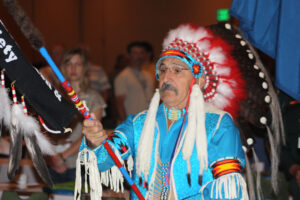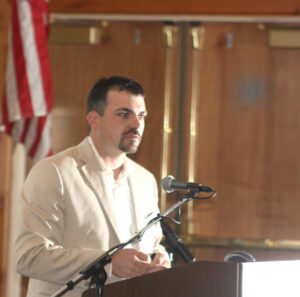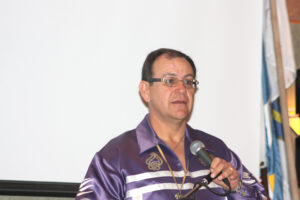EBCI co-hosts 30th Annual Native American Fish & Wildlife Society National Conference
By SCOTT MCKIE B.P.
ONE FEATHER STAFF
Fish and wildlife officers, biologists, environmentalists and others concerned with the state of natural resources in Indian Country converged in Cherokee this week for a historic event. The Native American Fish and Wildlife Society (NAFWS) celebrated its 30th Annual National Conference at Harrah’s Cherokee Casino & Hotel.

Fred Matt, NAFWS executive director, carries the Eagle Staff during the opening of the 30th Annual National Conference of the Native American Fish & Wildlife Society at Harrah's Cherokee Casino & Hotel on Tuesday, May 1. (SCOTT MCKIE B.P./One Feather photos)
The event, which started on Tuesday, May 1 and was scheduled to run through Thursday, May 3, was co-hosted by the Eastern Band of Cherokee Indians and the Houlton Band of Maliseet Indians. The conference had the theme of “Weaving Together the Strands of Creation”.
“I want to welcome you to Cherokee,” said Principal Chief Michell Hicks as he helped open the conference on Tuesday morning. “It’s a beautiful time of year here. We’re excited about the week.”
The program began with an opening song and flag song by the Awohali Singers from Cherokee.
“Every year, I am just amazed at how these national conferences just get better and better,” said Fred Matt, a member of the Salish Kootenai tribe and executive director of NAFWS. “The quality of presentations, the quality of speakers has just gotten to be none other than the best ever.”
Brian Patterson, a member of the Oneida Nation of New York, is the president of USET (United South and Eastern Tribes, Inc.) and was the keynote speaker for Tuesday’s session. He told the group, “Your work is not about the trout. Your work is not about just the salmon. Your work is about the sustainability of our people.”
He said Indian Country is currently responsible for managing 141,000 square miles of land. “Respect for Mother Earth is in our DNA. It is our responsibility to make sure that these vast resources are taken care of and preserved for future generations.”
“The conference theme, ‘Weaving Together the Strands of Creation’, reminds us that there is strength in unity,” said Patterson who said climate changes are presenting challenges to those seeking to protect the environment.

Forest Parker, EBCI Natural Resources and Conservation director, speaks during the first presentation of the conference.
“We are not talking about preventing climate change, but addressing and adapting to climate change. Everything is relevant within the strands of life.”
Patterson related that American Indians are the world’s “leading experts in taking care of Mother Earth”.
“We are the caretakers for the generations to come, and what we weave today will be their legacy. The work you’re doing, the impact you make is great.”
The first presentation of the conference was an overview of EBCI environmental efforts entitled “Conservation and Management of Cherokee Fish and Wildlife Resources” presented by Forest Parker, EBCI Natural Resources and Conservation director; Robert Blankenship, Cherokee Fisheries and Wildlife Management manager; and Mike Levoie, fish/wildlife biologist with Cherokee Fisheries and Wildlife Management.
Parker told the group that historic Cherokee lands comprised over 400,000 square miles and was made up of mountains and rich valleys. Today, he said, EBCI lands total a little over 65,000 acres with only 5,700 acres being in the Tribal Preserve.
“Cherokee culture is extremely diverse,” said Parker. “Our culture and our history mimics the diversity in the area.”
He related that on EBCI lands there are over 100 species of trees and over 1,400 types of flowering plants. “The ecosystem is unbelievable. We are a people of the land.”
Parker gave a brief history of Cherokee natural resources management from the 1800s to the present. He spoke briefly about the formation of the EBCI Office of Environment and Natural Resources in 1996 and the Qualla Environmental Resources Proclamation by Chief Hicks in 2006.
“This current administration has been the most proactive and most concerning administration in the history of this Tribe as it relates to natural resources and fish and wildlife management,” said Parker. “In 2006, Chief Hicks signed the Environmental Proclamation which is a proclamation promoting a healthy, sustainable environment through developing and Integrated Resource Management Plan, working collaboratively with other governments to manage our natural resources while maintaining our sovereign interests.”
LaVoie spoke about several wildlife species the EBCI is working to help preserve including Appalachian brook trout, sicklefin redhorse, wild turkey, black bear, elk, whitetail deer and bat.
Robert Blankenship gave an overview of the trout fishing program in Cherokee which utilizes roughly 30 miles of Tribal Enterprise Waters. He said the economic impact to Cherokee from trout fishing is around $18-$20 million annually.
The conference continued on Tuesday with discussions on topics such as: “The Puyallup Tribal Homelands & Eco-Cultural Restoration: Past Present & Future”, “The 1st Tribal National Park”, “Tribal Conservation Wildlife Law Enforcement” and a panel discussion on climate change.
For more photos from this event, please visit the One Feather photo gallery:






